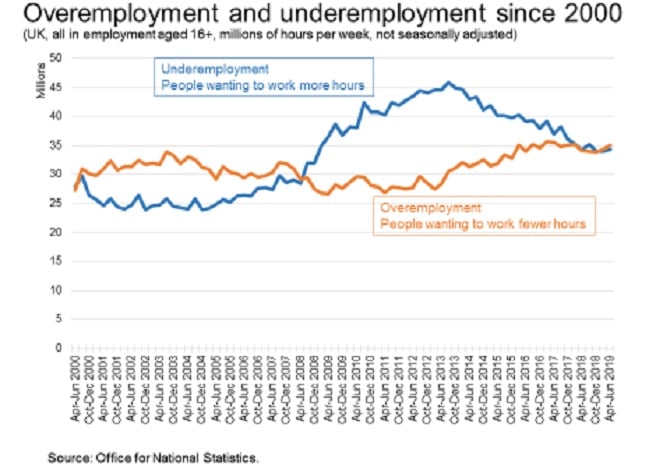Such a commitment would be radical. The Working Time Regulations specify a maximum working week of 48 hours (averaged over 17 weeks) but this can be waived with the employee’s consent. Even the French – never knowingly under-regulated – only went as far as a 35-hour week law, something that was diluted by subsequent governments. A 32-hour maximum – even excluding breaks – would be well below whatever has been set in law or collective agreements elsewhere.
And a 32-hour week might be popular. According to the 2019 UK Working Lives Survey, 41% of employees who usually worked for 35 or more hours each week said they would choose to work 35 hours a week or less if they could choose freely. And since that question reminded employees of “the need to earn your living”, it’s safe to assume the percentage would be higher if the need to earn a living was taken care of.
However, a 32-hour maximum working week doesn’t seem to be what Labour is proposing, at least not straight away. The proposals are more partial, more gradual and – Labour would argue – more pragmatic.
Labour movements around the world have campaigned for reductions in working time without loss of pay – right back to the campaign for an 8-hour day which originated in the nineteenth century. The TUC has recently spoken about achieving a four-day working week this century. McDonnell wants to increase the role of collective bargaining in the economy – and, since trade unions seek reductions in working time, this ought to deliver, first, for those workers covered by collective agreements and, second, for other workers if their employers emulate unionized firms.
Labour hasn’t been clear exactly how this would be achieved. A statutory union recognition procedure already exists but is not used greatly. Even with tweaks to make it more union-friendly, it is difficult to see it operating at the required scale. If McDonnell wants to expand the influence of collective bargaining quickly, he will need a version of the Fair Wages Resolution, abolished in 1980, or the Wages Councils, abolished in 1992.
McDonnell’s institutional innovation would be to set up a Working Time Commission. Modelled on the Low Pay Commission, this would examine after-the-fact data on how many hours people work and, if they thought progress in reducing working time wasn’t sufficient to meet the long-term objectives of the policy, recommend something is done to help achieve it. This “something” would be the minimum number of days paid leave contained in the Working Time Regulations – currently 20 (excluding public holidays), although many employers already offer more. Pushing up this minimum would reduce the number of hours employees work each year even if employees didn’t reduce the number of hours they work each week – assuming, of course, that they take the extra leave.
McDonnell sees this as a policy for the long-term – he talks about the 32-hour week being a ten-year aspiration. But it sets a tone: employees would see the benefits of higher productivity accrue to them through reduced working time rather than (or as well as) higher wages.
This brings us to the first potential problem with this proposal – it assumes there are gains from higher productivity to spread around. But productivity growth during the past decade has been anemic. Labour will claim they have other policies to address this, but what if they don’t work? Arguably, the Working Time Commission would take this into account when considering the affordability of more paid leave – but what would happen if the misgivings of a nominally independent institution were to clash with Ministerial aspirations?

A second problem is unpaid hours. This policy probably works better in situations where all hours are paid. But many people work unpaid overtime. Giving them more paid leave might hardly improve matters if their workload remained unchanged.
Enforcement may also be an issue. There are already concerns about compliance with the annual leave and holiday provisions of the Working Time Regulations. Strengthening them would probably add to these.
Finally, what if the economy turns – which is a fairly safe bet during a ten-year period? For most of the past ten years, the dominant problem has not been too much work, but too little work – underemployment has exceeded overemployment (see chart).
Another downturn – especially if it was accompanied by a squeeze on earnings – might dent employees’ enthusiasm for a shorter working week.







